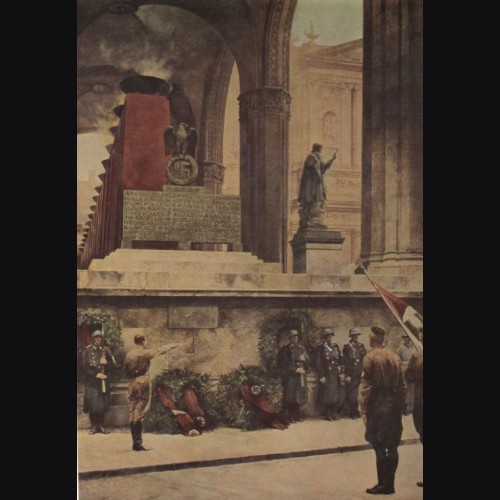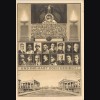Felderrnhalle # 835
The Feldherrnhalle
Munich is the birth place of the NSDAP and home to one of the last surviving buildings that the Nazi’s considered their most important shrine.
The Felherrnhalle was built in 1844 by Friedrich von Gaertner and modeled on the Loggia dei Lanzi in Florence. It was erected to honor the heroes of the Franco-Prussian War. The three statues were designed by Schwanthaler. The statue on the left is of Count Tilly, the one on the right is Prince Wrede and the grand center statue is of a Bavarian warrior holding a standard with a maiden and lion. The two grand lions located in front were added later in the century.
The Felderrnhalle, located in the Odeonsplatz area of Munich, became the focal point of Hitler’s Beer hall Putsch on the 9th on November 1923 when Hitler and his followers were met by the Munch Police. Fourteen Party members were shot and killed on the east side of the building, making the first important early martyrs of the movement. A total of sixteen Party members were killed that day with the other two being at the War Ministry. The Feldherrnhalle also became the place where the sacred Blood Flag was born when SA member Andreas Bauriedl becoming mortally wounded, fell upon the flag staining it with his blood.
From that day forth, the Feldherrnhalle became the most important building in the birth place of the movement. Each year after Hitler took power, he and his early followers, proudly wearing their Blood Order Medals, marched the path of the original Putsch ending at the Feldherrnhalle for an elaborate ceremony honoring the dead. On the east side of the Feldherrnhalle, Hitler had erected a large bronze plaque designed by Paul Ludwig Troost with the names of the sixteen names of the fallen. From that day forth, when the citizens of Munich passed the Mahnmal, they were required to salute.
At the end of the war, the Feldherrnhalle suffered very
little damage and the Mahnmal, erected by Hitler to the fallen, was torn down by
the citizens of Munich after the Americans entered the city. Even today if you
happen to be in Munich around the 9th of November you can sometimes
see an old timer glance at the once proud monument of the movement.
Photo Credits: Erich Schaefer
Article by Erich
Schaefer
The Feldherrnhalle
Munich is the birth place of the NSDAP and home to one of the last surviving buildings that the Nazi’s considered their most important shrine.
The Felherrnhalle was built in 1844 by Friedrich von Gaertner and modeled on the Loggia dei Lanzi in Florence. It was erected to honor the heroes of the Franco-Prussian War. The three statues were designed by Schwanthaler. The statue on the left is of Count Tilly, the one on the right is Prince Wrede and the grand center statue is of a Bavarian warrior holding a standard with a maiden and lion. The two grand lions located in front were added later in the century.
The Felderrnhalle, located in the Odeonsplatz area of Munich, became the focal point of Hitler’s Beer hall Putsch on the 9th on November 1923 when Hitler and his followers were met by the Munch Police. Fourteen Party members were shot and killed on the east side of the building, making the first important early martyrs of the movement. A total of sixteen Party members were killed that day with the other two being at the War Ministry. The Feldherrnhalle also became the place where the sacred Blood Flag was born when SA member Andreas Bauriedl becoming mortally wounded, fell upon the flag staining it with his blood.
From that day forth, the Feldherrnhalle became the most important building in the birth place of the movement. Each year after Hitler took power, he and his early followers, proudly wearing their Blood Order Medals, marched the path of the original Putsch ending at the Feldherrnhalle for an elaborate ceremony honoring the dead. On the east side of the Feldherrnhalle, Hitler had erected a large bronze plaque designed by Paul Ludwig Troost with the names of the sixteen names of the fallen. From that day forth, when the citizens of Munich passed the Mahnmal, they were required to salute.
At the end of the war, the Feldherrnhalle suffered very
little damage and the Mahnmal, erected by Hitler to the fallen, was torn down by
the citizens of Munich after the Americans entered the city. Even today if you
happen to be in Munich around the 9th of November you can sometimes
see an old timer glance at the once proud monument of the movement.
Photo Credits: Erich Schaefer
Article by Erich
Schaefer



-100x100.jpg)
-100x100.jpg)
-100x100.jpg)
-100x100.jpg)
-100x100.jpg)
-100x100.jpg)
-100x100.jpg)
-100x100.jpg)
-100x100.jpg)
-100x100.jpg)
